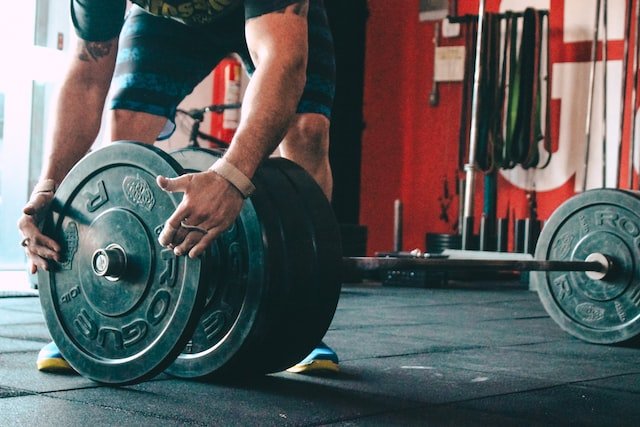Why Do I feel Bicep Curls In My Shoulders? 16 Crucial Tips For Better Results
Bicep curls are one of the most popular exercises for building upper body strength.
However, sometimes, people may feel the exercise in their shoulders instead of their biceps.
There are several reasons why this may happen and it’s well worth getting to the bottom of the issue so you can get back to enjoying your workouts and seeing results.
Why Do I feel Bicep Curls In My Shoulders?
You may feel bicep curls in your shoulders for various reasons, such as improper form, using too much weight, or not engaging your core muscles. Bicep curls are a compound exercise that work multiple muscle groups, so it’s important to use proper form and technique to avoid injury and maximize results. If you’re new to working out, start with lighter weights and focus on form before increasing the amount of weight you lift. Additionally, be sure to engage your core muscles during the exercise to protect your lower back and improve stability. If you have any pain or discomfort in your shoulders during the exercise, stop and consult a doctor or certified personal trainer before continuing.
Too heavy
One of the most common reasons people feel bicep curls in their shoulders is because they are lifting a weight which is too heavy for them.
Make sure you are using a weight that is appropriate for your fitness level.
If the weight is too heavy, you may find yourself using momentum to lift the weight, which can cause you to feel the exercise in your shoulders instead of your biceps.
Additionally, using too much weight can lead to injury. If you are new to working out, start with lighter weights and focus on form before increasing the weight.
We have all seen those people at the gym, who are fascinating to watch for all the wrong reasons with regards to the way they lift due to the weight being too heavy for them, as it’s like watching a comedy sketch.
Don’t be one of those people, pick a weight that’s heavy enough that you can do the exercise with the correct form.
Not engaging your core
Another common reason people may feel bicep curls in their shoulders instead of their biceps is that they are not engaging their core muscles.
When you engage your core muscles, it stabilizes your spine and pelvis, which gives you a strong foundation to lift from.
If you don’t engage your core muscles, you may find yourself arching your back or swinging the weight, which can put unnecessary stress on your shoulders and lead to injury.
Make sure you engage your core muscles by drawing your belly button towards your spine and keeping your back straight.
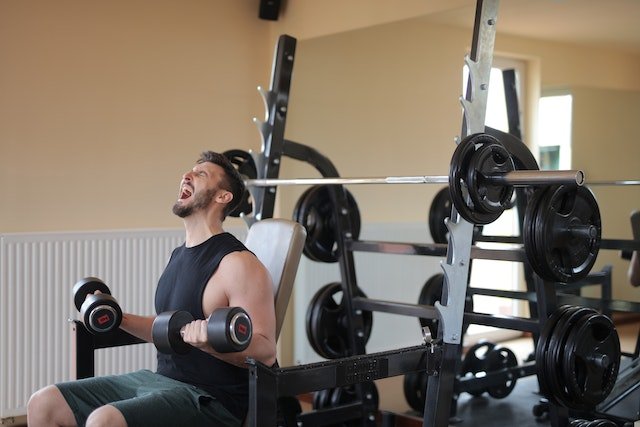
Improper form
If you don’t have the proper form when doing bicep curls, you may find yourself using momentum or swinging the weight, which can put unnecessary stress on your shoulders.
It’s important to use a slow and controlled motion when doing bicep curls.
Focus on squeezing your biceps at the top of the curl and slowly lowering the weight back down.
If you find yourself swinging the weight or using momentum to lift it, lower the weight and focus on using proper form.
Related: Do Kettlebell Cleans Work Biceps? (All You Need To Know Here)
Keep elbows tight to your side
When doing bicep curls, think about hinging from the elbow and not moving the shoulder.
When your elbows start to drift away from your sides, this is when people start to feel it in their shoulders.
Another tell-tale sign of poor form is when people start to scoop the barbell up, with their elbows pointing forward, to shift the weight they are trying to curl.
This is a sure sign of curling a weight that’s too heavy.
Keep your elbows tight to your sides and focus on hinging from the elbow to get the most out of the exercise and avoid feeling it in your shoulders.
Use a full range of motion
When doing bicep curls, make sure you are using a full range of motion.
This means curling the weight up until your biceps are fully contracted and then lowering the weight all the way down.
Partial reps may help you lift heavier weights and can be helpful as a change to your routine, but they won’t be as effective in building muscle.
Additionally, partial reps can put unnecessary stress on your joints and lead to injury.
Leaning backwards or forwards
When doing bicep curls, you want to maintain an upright position.
This means not leaning backwards or forwards during the exercise.
If you lean backwards, you may find yourself using momentum to lift the weight.
And if you lean forwards, you may put unnecessary strain on your lower back.
Both of these can lead to injury, so make sure you maintain an upright position throughout the exercise.
This happens frequently whenever people try to lift a weight that’s too heavy, by swinging their torso to gather momentum to curl the weight.
Doing so activates other muscles that were not meant to be used during this exercise, which puts unnecessary strain on the body and can lead to injury.
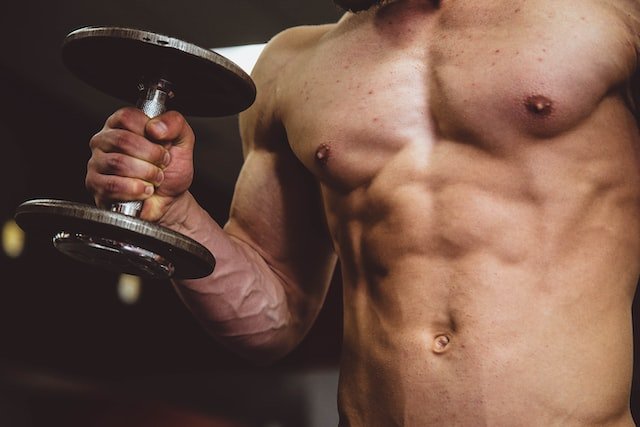
Swinging arms for momentum
When doing bicep curls, some people may find themselves swinging their arms for momentum.
This is often a sign that the weight is too heavy for them.
You won’t also get much out of the exercise, due to the fact the biceps aren’t being worked as hard when using momentum.
Focus on using a slow and controlled motion to curl the weight up and down.
Swinging your arms to generate momentum puts unnecessary stress on your shoulders and can lead to injury.
It’s important to use a weight that you can lift with proper form and technique.
If you find yourself swinging your arms for momentum, lower the weight and focus on using proper form with your elbows tucked firmly by your side.
Retract shoulders
When doing bicep curls, make sure to retract your shoulders.
This means pulling them back and down away from your ears.
If your shoulders are rounded forward, it puts unnecessary strain on the muscles and tendons in the shoulder.
As ever, lifting heavy weights will naturally make you round your shoulders to be able to shift the load you are trying to lift.
This can lead to pain and discomfort, and may even lead to injury.
Make sure to keep your shoulders retracted throughout the exercise to avoid any pain or discomfort, as well as having the best form possible to get the most out of curling the weight.
Slow down movement
When doing bicep curls, some people may find themselves using a jerky motion to curl the weight.
This can often lead to pain in the shoulder, as well as being less effective in working the biceps.
Curling the weight in a smooth and controlled motion will give you the best possible muscle contraction in the biceps, as well as avoid any pain or discomfort in the shoulders.
Focus on using a slow and controlled motion to curl the weight up and down.
If you find yourself using a jerky motion, lower the weight and focus on using proper form with your shoulders retracted and your elbows tucked firmly by your torso.
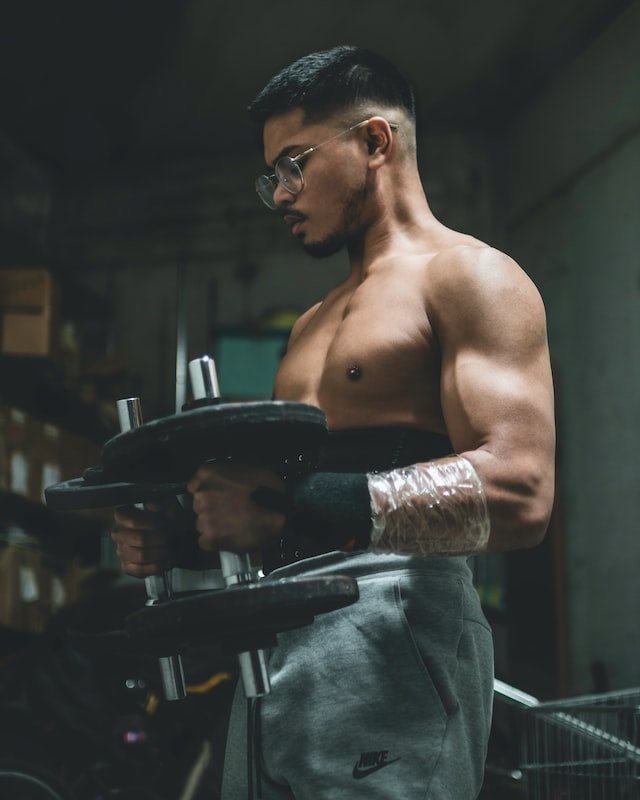
Breathing
Make sure to exhale during the effort phase of the movement, when you are curling the weight up.
Inhale during the release phase, when you are lowering the weight down.
Many people hold their breath when lifting weights, but this can actually lead to dizziness and lightheadedness.
It’s important to breathe during the exercise to avoid these symptoms, as well as to get the most out of the exercise.
If you find yourself holding your breath, take a break and focus on breathing evenly throughout the exercise.
Grip
Your grip on the barbell or dumbbell will impact how effective the exercise is, as well as your risk of injury.
For bicep curls, you want to have a close grip, with your palms facing up.
Your grip should be just outside of shoulder width.
If your grip is too wide, it will put unnecessary strain on your shoulders.
If your grip is too narrow, it will be difficult to keep your elbows by your side and will put extra strain on your wrists as you curl the bar up.
The close grip is the most effective grip for this exercise, as it allows you to keep your elbows by your side and curl the weight up without putting strain on your wrists or shoulders.
Curl variations to try
There are quite a few variations to try along with some that make use of dumbbells.
Preacher curl – Sit at a preacher curl bench with your palms facing up and your arms extended straight. Curl the weight up, making sure to keep your elbows by your side.
Hammer curl – Start with your palms facing your thighs and your arms extended straight. Curl one weight up, making sure to keep your elbow by your side. At the top of the curl, twist your wrist so that your palm is facing your shoulder. Lower the weight back down and repeat with the other arm.
Concentration curl – Sit on a bench with your palms facing up and one weight in your hand. Place the back of your upper arm on your thigh and curl the weight up. Make sure to keep your elbow stationary and by your side. Repeat with the other arm.
Incline curl – Sit on an incline bench with your palms facing up and your arms extended straight. Curl the weight up, making sure to keep your elbows by your side.
wall curl – Stand with your back to the wall and your palms facing up. Curl the weight up, making sure to keep your elbows by your side.
These are just a few variations of bicep curls that you can try to mix up your routine.
Feel free to experiment with different grips, weights, and angles to find what works best for you
Are delts fatigued?
One of the main reasons people feel bicep curls in their shoulders is because their delts are already tired from a previous session.
If you’ve been doing a lot of overhead pressing or other shoulder-intensive exercises, your delts may be tired before you even start your bicep curls.
This can lead to your shoulders taking over the exercise and putting extra strain on your rotator cuff.
To avoid this, make sure to give your delts a break before doing any bicep curls.
You can also try doing some lighter shoulder exercises, such as raises, before doing your bicep curls to warm up your delts and get them ready for the exercise.
Related: Why Is One Arm Stronger Than The Other? (All The Answers For Perfect Symmetry)
Weak shoulders?
If your shoulders are weak, they may not be able to handle the weight you’re using for your bicep curls.
This can lead to poor form and your shoulders taking over the exercise.
To avoid this, make sure to use a lighter weight until you build up the strength in your shoulders.
You can also try doing some shoulder exercises, such as raises and presses, to help build up the strength in your shoulders.
If you have any muscle imbalances, it can lead to your shoulders taking over the exercise.
For example, if your pecs are stronger than your lats, your shoulders may start to take over the exercise because your pecs are trying to do most of the work.
To avoid this, make sure to focus on building up the strength in your secondary muscles.
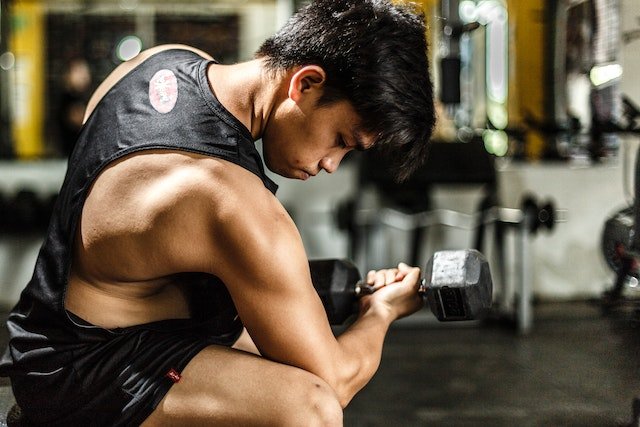
Range of motion issues?
If you have any range of motion issues in your shoulders, it can lead to your shoulders taking over the exercise.
For example, if you have poor shoulder mobility, your shoulders may start to take over the exercise because they can’t move through their full range of motion.
To avoid this, make sure to focus on stretching and mobility work for your shoulders.
If you’ve recently injured your shoulder, it’s important to be careful when doing any exercises that put strain on the area.
For example, if you’ve had a rotator cuff injury, you may want to avoid any exercises that put strain on the area, such as bicep curls.
Talk to your doctor or physical therapist before starting any new exercise routine.
Change routine order?
The order of exercises can also play a role in whether or not your shoulders take over the exercise.
If you are wanting to prioritise your biceps, then it is recommended that you do bicep curls as the first exercise in your routine.
Doing bicep curls first will help to pre-fatigue your shoulders and ensure that your biceps are doing most of the work.
If you are wanting to focus on building up the strength in your shoulders, then it is recommended that you do shoulder exercises first.
Doing shoulder exercises first will help to ensure that your shoulders are strong enough to handle the weight you’re using for your bicep curls.
Final thoughts…
There are a variety of reasons why you may feel bicep curls in your shoulders.
If you are feeling pain or discomfort in your shoulders, it’s important to see a doctor or physical therapist to rule out any serious injuries.
Otherwise, focus on using proper form and technique, and experiment with different grips, weights, and angles to find what works best for you.
Do you have any problems doing bicep curls and how have you fix the issue? Let us know in the comments below.


